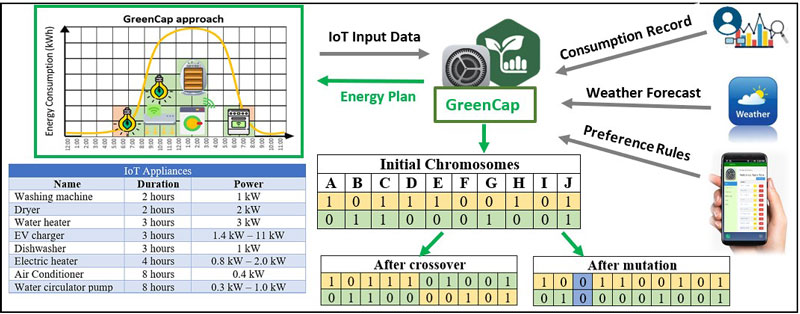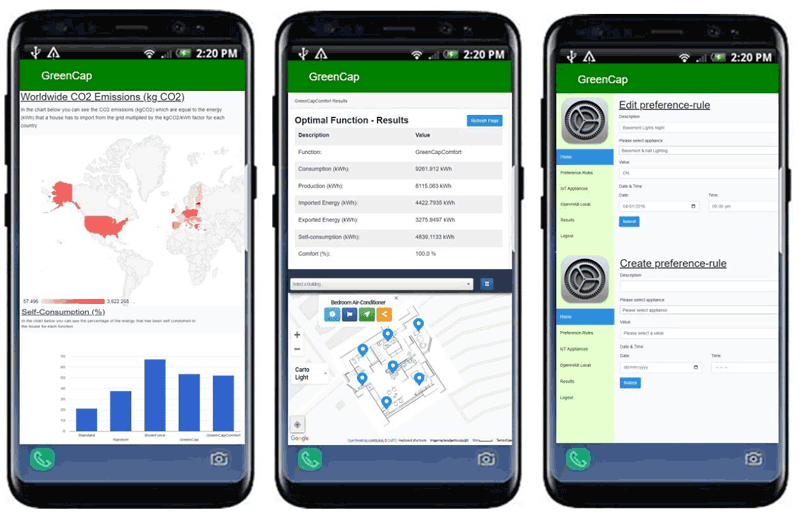by Soteris Constantinou (University of Cyprus), Andreas Konstantinidis (Frederick University) and Demetrios Zeinalipour-Yazti (University of Cyprus)
Due to the global energy crisis and increasing CO2 emissions, energy efficiency has become a crucial focus. This has led to an increased usage of solar photovoltaic power generation in residential buildings to meet climate and energy targets set by the “Paris Agreement”. With the growing number of Internet of Things (IoT) devices, implementing an intelligent home energy management system can offer energy and peak demand savings. However, planning the optimisation of these devices faces challenges due to the user-defined preference rules, and convergence issues arise when managing multiple IoT devices. We have devised a novel IoT data management system, called GreenCap, which uses a Green Planning evolutionary algorithm. The system focuses on load shifting of IoT-enabled devices, considering factors such as integrating renewable energy sources, managing multiple constraints, peak-demand times, and dynamic pricing. We have implemented a complete prototype of the GreenCap system on Raspberry Pi, connected with the openHAB framework, able to generate sustainable plans ensuring a high level of user comfort and self-consumption, while significantly reducing the imported energy from the grid and CO2 emissions.
Residential loads constitute a substantial portion of the overall demand placed on utility grids, with this figure steadily expanding in tandem with the increasing proliferation of various associated applications. The global count of IoT-connected devices is anticipated to reach 30.9 billion units by the year 2025, and is further projected to soar to 100 billion connected devices by 2030 [2]. The global market for home energy management systems (HEMS) has witnessed substantial growth, expanding from US$864.2 million in 2015 to US$3.15 billion by the year 2022 [3]. The Paris Agreement solemnly signed in New York City on April 22th 2016, falls under the United Nations Framework Convention on Climate Change and encompasses the areas of greenhouse gas emissions mitigation, adaptation, and finance. There has been a significant escalation of approximately 140% in the financial repercussions associated with power generation pollution in the year 2021.
Green Planning encompasses computational methodologies that strive to expedite sustainable advancements by implementing load-shifting strategies that address peak-demand reduction. This approach is distinguished by its long-term perspective, intending to supplant conventional environmental protection methods by incorporating economic realities while preserving ecological values and natural resources. An essential catalyst for managing energy consumption and mitigating CO2 emissions lies in the widespread adoption of the IoT infrastructure. This interconnected network facilitates seamless communication and operation among numerous intelligent devices globally, all capable of executing diverse functions while adhering to open communication protocols. Therefore, the convergence of energy usage and CO2 emissions governed by IoT infrastructure can be achieved, aligning both aspects seamlessly within a unified framework. Further, the self-consumption of renewable energy sources continues to serve as a supplementary measure in meeting the current and future imperative of fostering a cleaner environment. This approach holds notable advantages over energy-storage batteries, where approximately 17% of the energy is lost due to AC/DC conversion losses and heat dissipation. It embodies a decentralised in-situ strategy that necessitates minimal infrastructure and predominantly relies on smart planning algorithms for achieving energy reduction. Empirical evidence has demonstrated that this method yields more than a 70% reduction in energy consumption within households. Consequently, the mitigation of CO2 pollution in areas of human activity, where individuals typically spend 80–90% of their time, can exert a favourable influence on the environment. As part of the European Commission Green Deal, it was decided to reduce net greenhouse gas emissions by at least 55% by 2030, compared to 1990 levels, and become neutral by 2050.
In GreenCap, a user starts out by defining a set of Preference Rules (PR), and a Residential Consumption Record (RCR) history. The primary objective is to effectively compute a sustainable real-time operating schedule that aligns the specified daily operation intervals of the listed devices with the solar production curve, while taking into consideration peak-demand periods, user comfort preferences (i.e. PR) and RCR [1]. By employing an evolutionary algorithm, we effectively harness bio-inspired operators, such as mutation, crossover and selection, to craft a high-quality solution for the particular search problem to strategically schedule the operation of appliances during off-peak hours and high production periods. These adaptive mechanisms emulate the principles of natural selection and genetic variation, enabling the algorithm to iteratively improve and refine the solutions over successive generations, ultimately converging towards a sub-optimal yet practical outcome. The genetic algorithm’s ability to explore diverse solution spaces and exploit favourable characteristics makes it well-suited for tackling the complexity inherent in the particular domain problem. Furthermore, the integration of a genetic algorithm with domain-specific local search heuristics culminates in the development of a Memetic Algorithm (MA). This hybridisation yields notable enhancements to user fitness and substantially augments convergence by mitigating the risk of becoming trapped in local optima.

Figure 1: A daily planning representation of the GreenCap approach. The GreenCap is liable to find a sustainable plan for the operation of IoT devices by only using a Preference Rules (PR) table, a Residential Consumption Record (RCR) history, and a weather forecast. Each IoT device is represented with a letter in the chromosomes stack of the memetic algorithm (MA), and their state is indicated with 1 = ON or 0 = OFF.

Figure 2: GreenCap graphical user interface: interfaces displaying consumption results, algorithm’s performance, dashboard for smart space – Anyplace Viewer, and create/edit portals for preference rules (PR).
Our system architecture comprises a custom main control unit, capable of integration with either openHAB or Domoticz, functioning as a smart residential management application; the GreenCap Controller, a component encompassing the entire energy management logic; and the web-based graphical user interface (GUI). The system development involved the use of Laravel Model-View-Controller framework, in conjunction with the Linux crontab daemon. It is designed to seamlessly integrate with openHAB or Domoticz platforms. The GUI is integrated into the web portal and mobile application of openHAB, enabling efficient control of IoT devices and automated management of sustainability-aware Preference Rules.
The proposed framework can be easily integrated in low-end edge-smart actuation platforms such as Raspberry Pi. We claim that the implementation of intelligent energy consumption strategies, exemplified by green-smart IoT actuations, holds the substantial potential to significantly benefit the environmental footprint. This advancement aligns with environmental objectives, thus facilitating the attainment of established sustainability goals.
Link:
[L1] https://greencap.cs.ucy.ac.cy/
References:
[1] S. Constantinou et al., “An IoT data system for solar self-consumption”, in 24th IEEE Int. Conf. on Mobile Data Management (MDM'23), IEEE Press, pp. 10, 2023.
[2] “Statista – IoT and non-IoT connections worldwide 2010-2025”. [Online]. https://tinyurl.com/mw74ku2h
[3] “Home energy management system market by hardware, by communication technology and by software and service”. [Online]. https://tinyurl.com/bp82pwmt
Please contact:
Demetrios Zeinalipour-Yazti, Data Management Systems Laboratory (DMSL), Department of Computer Science, University of Cyprus










